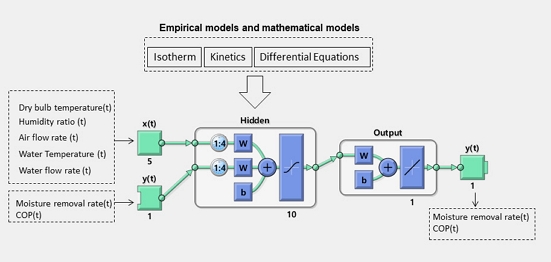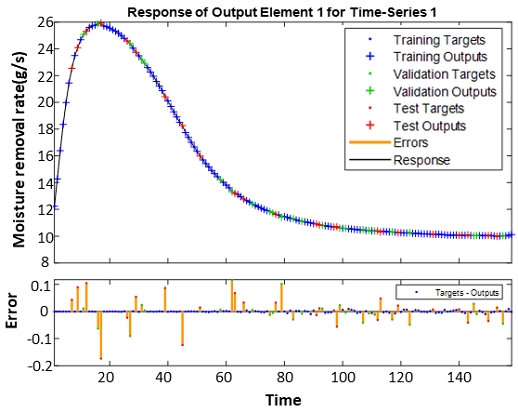
Application of Artificial Neural Network (ANN) Model for Performance Prediction of a Desiccant-coated Heat Exchanger via COP and Vapor Removal Capacity
ⓒ 2023. KIEAE all rights reserved.
Abstract
This study has been carried out to assess the performance of a desiccant-coated heat exchanger (DCHX) by the application of an artificial neural network (ANN) model, where its performance was evaluated via water vapor removal capacity and coefficient of performance (COP).
The DCHX was prepared by coating the surface of finned tubes using adsorbent powder. Each tube had the dimensions of 200 mm x 150 mm x 22 mm and 0.1 mm thick with a spacing of 1.5 mm. Four tubes pass through a fin, where a tube of 9.5 mm in diameter is used. As for the input data of the ANN, different conditions (parameters) were used for air and water streams. Especially, two different regeneration temperatures (50oC, 80oC) were tested to explore its effect on the development of ANN model. The ANN model was trained by employing 162 data samples from the previous experimental study. To study feed forward and backward propagation, MATLAB code was extensively used as appropriate. For the training of the ANN model, three-fourths of the experimental data was used and the remaining was used for its test and validation.
The results show the maximum difference of 0.05 for COP and 0.01 for water vapor removal rate between the ANN model and experimental data. Also, the difference in the regeneration temperature has little effect in affecting the development of the ANN model. This indicates the possible development of a universal ANN model applicable to different operating conditions. The present analysis could be further extended to explore the performance of the DCHX in the context of the 2nd law of thermodynamics.
Keywords:
ANN Model, Performance Prediction, Desiccant-Coated Heat Exchanger (DCHX), COP, Vapor Removal Capacity키워드:
인공신경망 모델, 성능 예측, 흡착제코팅열교환기, 성능계수, 수분제거능1. Introduction
Condensation dehumidification and desiccant dehumidification mainly comprises the dehumidification processes. The former has been largely applied in various types of vapor compression cooling systems driven by compressors. Air is cooled to dew point temperature before it is condensed via an evaporator removing moisture (vapor) content in the air. Sensible and latent heat are dealt with in the evaporator resulting in a lower evaporation temperature (~ 5 °C), which enables pleasant air temperature and relative humidity[1]. Although, the technology is simple in its operation and has been widely used, there have been a number of issues concerning sustainability arising from the perspective of energy and environmental matters. Although the technology has been developed continuously over the years, the inherent difficulties are yet to be resolved completely. Desiccant dehumidification, which separates latent cooling from sensible cooling in air handling units (AHUs) in buildings, is one potential remedy to reduce the abovementioned issues.
Meanwhile the dehumidification technology, based on a desiccant-coated heat exchanger (DCHX), has gained increasing interest due to its reliable and eco-friendly nature around the world, especially in humid regions. DCHX is different from conventional vapor-compression technology based refrigeration cooling systems with energy consuming compressors, it is capable of delivering dehumidication and cooling when applied to a direct or indirect evaporative cooling systems. Dropping the air temperature below its dew point is not required for the removal of moisture content in the air as practiced in the conventional vapor compression cooling cycles[2-3]. DCHX has a broad range of applications where humidity control, energy efficiency, and moisture removal are crucial considerations such as HVAC systems, industrial drying process, energy recovery systems and data centers.
There are currently many studies performed to develop theoretical models capable of predicting the performance of the DCHX via a white-box model applying the physical principles as appropriate. This, however, is not simple as detailed information on the DCHX is required such as thermal and physical properties of desiccant as well as technical details of the heat exchanger[4-7]. In this studying non-linear cases of a desiccant system, application of the artificial neural network (ANN) is an effective approach for modeling the physical phenomenon of adsorption-based dehumidification and exploring its operational characteristics in light of input and output parameters. Desiccant coated heat exchangers involve intricate interactions between multiple variables, and ANNs excel at learning and representing these nonlinear relationships. In contrast, white-box models, such as analytical or empirical equations, may struggle to accurately capture and model these complex interactions.
These parameters can be ultimately construed in important thermodynamic terms representing the efficiency of a thermal system such as COP as they carry the pieces of practical information reflecting its operational characteristics. Here, the efficiency of the DCHX is represented by COP as it denotes the functional robustness of a thermal system requiring work to accomplish the objective of operating a thermal system.
The water removal rate of the DCHX is also deal with in the present analysis as it gives the tangible information concerning the necessity of operating a thermal system (the DCHX) in practical terms.
Of course, the analysis can be made from the perspective of the 1st and 2nd law of thermodyanmics depending on the nature of the input and output data with available parametric distributions.
To develop an ANN model, an arrangement has to be made concerning the structure and values for a set of hidden neurons and their corresponding layers such that they represent the complicated interactions between input and output parameters. A complex task can be effectively treated by the application of the ANN approach delivering a simple solution[8-10]. This, however, requires much work to obtain sets of experimental data spanning over a wide range of input parameters as they are used for the training an ANN model determining its usefulness. In the present paper, an extensive study has been carried out to explore the development of a proper model to assess the performance of a DCHX based dehumidification system where an artificial neural network is developed with a simple set of input-output parameters.
2. Operation of a Desiccant Coated Heat Exchanger (DCHX)
The removal of moisture from highly humid air (relative humidity of over 90%) can be effectively achieved by a desiccant-coated heat exchangers (DCHX), which uses adsorbents such as silica gel, Zeolite, and MOF. The DCHX studied in this work was prepared by using adsorbent powder to coat a finned tube heat exchanger.
The finned tube heat exchanger has the dimensions of 200 mm x 150 mm x 22 mm and the fin thickness is 0.1 mm with a spacing of 1.5 mm. Four tubes pass through a fin, where a tube of 9.5 mm in diameter is used. As shown in Fig. 1., two different modes are alternatively used to operate the DCHX: dehumidification (adsorption) mode, and regeneration (desorption) mode.

Operation of a desiccant-coated heat exchanger (DCHX) for dehumidication: (a) dehumidication (absorption) mode, (b) regeneration (desorption) mode
When the DCHX is operated in the dehumidification mode, adsorption heat is removed by the cooling water supplied through the tubes maintaining the desiccant layer at a lower temperature and thus enabling the highest uptake. Conversely, in the regeneration (desorption) mode, heat is provided to the dessicant layer by running through the tubes to remove the water vapor adsorbed in the previous process of adsorption. Each process continues to take place alternatively until there is no more uptake of moisture (vapor content in air) by adsorbent at a given temperature and vapor pressure.
3. Development of an artificial neural network (ANN) model
The removal rate of vapor content in the air and COP (coefficient of performance) are the two major indicators studied in this work to assess the performance of the DCHX-based dehumidifier. Fig. 2. shows the ANN model configuration developed in the present analysis, which comprises of input, hidden, and output layers. As shown, the input layer is made up of 5 input data, that is, dry-bulb temperature, specific humidity, air flow rate, water temperature, and water flow rate. The hidden layer is comprised of 10 neurons where the output layer gives the removal rate of vapor content in the air and COP. To predict the COP and removal rate of vapor content in the air separately, two ANN models have been developed namely the NARX network and the Levenberg-Marquardt algorithm.
The NARX(nonlinear autoregressive network with exogenous inputs) network was used for the prediction of future values, y(t), of the time series from past values of that time series. Unlike a standard auto-regressive model, which only uses past values of a time series to make predictions, the NARX network incorporates independent(exogenous) past values of another time series x(t). To train the NARX network, the levenberg-Marquardt algorithm was used in this work with 162 experimental data items being extracted (regeneration temperature of 50oC). Of these, 70% were used for training the ANN and 15% being used to check its validity while the remaining 15 % was used toward its testing. The ANN model has developed in the Matlab platform, where ‘narxnet’ function was employed to create the network. In addition, ‘trainlm’ was employed to train the network.
For the purpose of training, validation and testing of the ANN model, 162 experimental results were employed from a series of data gathering. During the experiment, the average temperatures of the inlet air for dehumidification and regeneration processes were 30°C and 35°C, respectively. The average temperatures of hot water was set at 50°C and 80 °C respectively. During dehumidification process, the inlet humidity ratio was kept close to 20g/kg while it was kept to close to 12g/kg during regeneration process. Cycle time was fixed at 300 seconds for all the cases. The moisture removal rate(dω) is the rate at which the water vapor is removed by the desiccant coated heat exchanger and calculated by Eq. 1. COP is defined as the latent cooling capacity(Ql) divided by the total input thermal energy(Qreg) used for regeneration process(Eq.2).
| (Eq. 1) |
| (Eq. 2) |
In Figs. 3. and 4., the experimental output data are presented with a red circle for the removal rate of vapor content in the air and COP, respectively. The input data (dry-bulb temperature, specific humidity, water inlet temperature, water flow rate, air flow rate) are also shown in the figures.
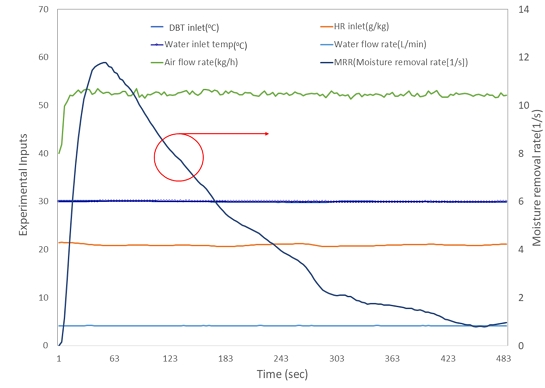
Experimental inputs and output data for the removal rate of vapor content in the air: experimental inputs includes DBT(Dry bulb temperature) inlet, HR(Humidity ratio) inlet, water inlet temperature, water flow rate and air flow rate
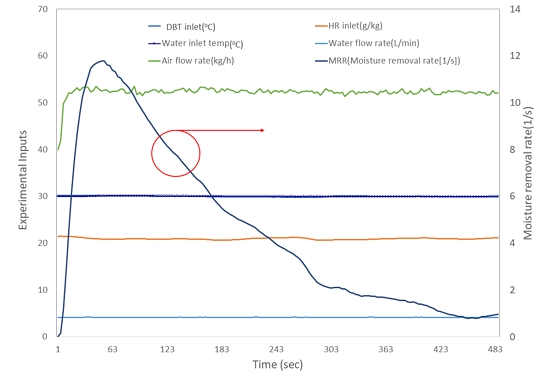
Experimental output data for the coefficient of performance (COP): experimental inputs includes DBT(Dry bulb temperature) inlet, HR(Humidity ratio) inlet, water inlet temperature, water flow rate and air flow rate
These input data are the crucial ones in exploring the operating characteristics as well as the performance of a thermal system as their variation along the system reflects the operational and functional characteristics.
4. Results and discussion
The Levenberg-Marquardt back propagation algorithm was used to train the ANN model and evaluated its performace with the mean square error (MSE). There were five parameters considered for the input layer that deems to dictate the functional effectiveness of the DCHX in its operation where dehumidification and regeneration takes place repetitively. These are the dry-bulb temperature, specific humidity, water inlet temperature, water flow rate and air flow rate as aforementioned. When the dehumidification process takes place, the vapor content in air is adsorbed releasing the adsorption heat carried away by cooling water. An efficient temperature dependent dehumidification process is possible by controlling the temperature of the cooling water. This is followed by the regeneration process where the desiccant is regenerated via DCHX. That is, the desiccant recovers its adsorption potential by making contacts with the hot air channeling through the DCHX. For this process, different forms of heat sources can be applied including those from sustainable energy resources which makes the use of DCHX more appealing than compressor based dehumidification.
Besides the properties of a desiccant including its dimensions, the system configuration also plays a crucial role in the operation and performance of a DCHX. As one cyclic operation of the DCHX comprises in two processes (dehumidification and regeneration) involving the opposite heat demands, it is very important to furnish highly efficient means of heating and cooling alternatively. For the output layer, two parameters were taken into consideration, namely, the removal rate of water vapor content in the air and COP. Although the COP presented here merely reveals the effectiveness of hiring DCHX from the perspective of the 1st law of thermodynamics, similar analysis for the application of an artificial neural network (ANN) model could be considered in light of the 2nd law of thermodynamics [11]. This requires applying the concept and definition of “reversible process” with the operation of DCHX, which assures the minimum work required to bring about the same effect in air conditioning as expressed by the experimental data in actual operations. Of course, the algorithm and approach used to develop ANN models can be applied as appropriate.
To explore the reliability of the present analysis, a regression analysis has been carried out where the predicted output and the corresponding targets (measured values) were used. In the present analysis, linearity has been assumed in the correlation of data where training, validation and test were performed. By carrying out this statistical analysis, the robustness of the present ANN model could be verified without undue difficulties.
Figs. 5. and 6. show the correlation that exists between the experimental and ANN-predicted values for the removal rate of vapor content in the air and COP, respectively. As shown in these figures, the values of the predicted output and corresponding targets show a linear pattern of correlation which validates the present analysis of liner regression irrespective of the regeneration temperature. That is, the ANN model delivers reliable results for different regeneration temperatures of 50oC and 80oC. The latter is well presented in our previous study[12].

Regression plots for training, validation and testing for the removal rate of vapor content in the air: (a) regeneration temperature (50oC), (b) regeneration temperature (80oC)[12]
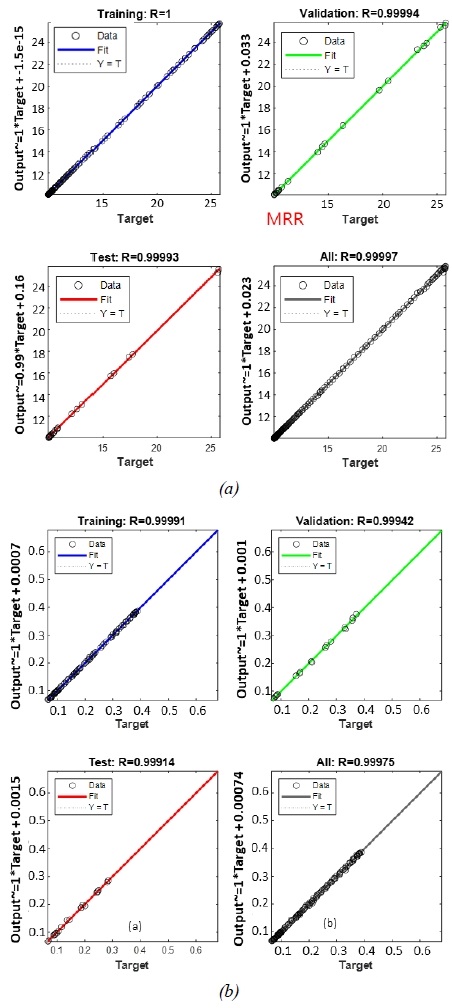
Regression plots for training, validation and testing for COP: (a) regeneration temperature (50oC), (b) regeneration temperature (80oC)[12]
As shown there is a good agreement between both values (i.e. ANN prediction vs measured data) concerning the removal rate of vapor content in the air and the COP showing high values of R2. Fig. 7. shows the performance of the developed ANN model. As for the removal rate of vapor content in the air, the MSEs of 7.59x10-4, 8.06x10-2, and 1.05x10-2 were observed for training, validation, and testing, respectively. On the other hand, as for the COP, the repective MSEs were 3.96x10-6, 1.24x10-2, and 1.60x10-3. This indicates that the ANN model is capable of delivering reliable prediction in dealing with the complex and nonlinear characteristics of the DCHX performance.
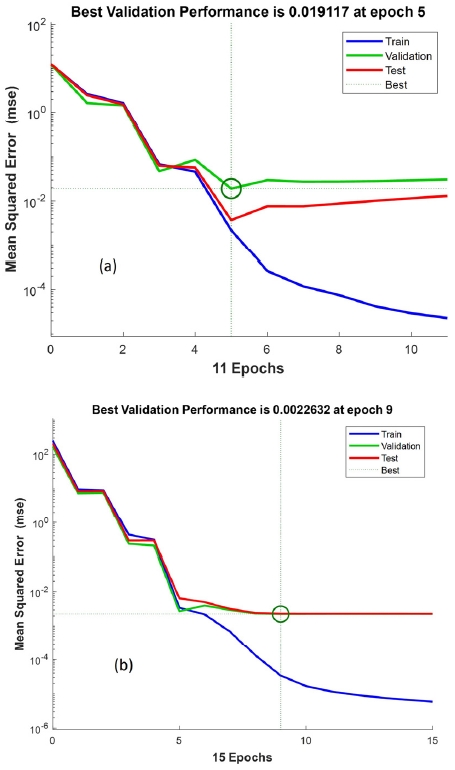
Mean Squared Error (MSE) for training, validation and testing: (a) removal rate of vapor content in the air (MRR) (b) COP
Figs. 8. and 9. show the various outputs, responses (targets) and errors plotted against time for the removal rate of vapor content in the air and COP, respectively. In these figures, it can be readily seen how time points were selected for training, testing, and validation. It is worthwhile to note in Fig. 8. that the ANN model predicts the removal rate of vapor content in the air with a very low error. This is also observed in Fig. 9. for the case of the COP.
5. Conclusions
This work deals with an artificial neural network (ANN) model in its performance prediction of a desiccant-coated heat exchanger (DCHX) used for dehumidification applications. Results are given in terms of the removal rate of vapor content in the air and coefficient of performance (COP), which are major functional indicators representing the performance of a DCHX. The former measures the tangible information in actual room conditioning while the latter gives the energy-efficiency of the DCHX in its operation.
As for the input layer of ANN, different conditions were considered for the air and water streams channeling through the desiccant-coated heat exchanger(DCHX). The ANN model developed was trained by the 162 data samples from previous experimental studies (regeneration temperature of 50oC) . Of these, 70% were used for training the ANN and 15% being used to check its validity while the remaining 15 % was used toward its testing. MATLAB code was extensively used in the analysis to study feed forward and backward propagation. The following findings can be inferred from this study:
(1) The ANN model presented has shown good agreement with the experimental data showing high values of R2(~1), which indicates its reliability and high accuracy irrespective of different regeneration temperatures of 50oC and 80oC.
(2) For the removal rate of vapor content in the air, the MSE of 1.05x10-2 was observed for testing. On the other hand, as for the COP, the repective MSE was 1.60x10-3.
(3) It can be concluded that the proposed ANN model could be applied to different operating conditions with reasonable accuracy.
This study aims to develop an ANN model using DCHX's experimental data and verify its performance. Design variables for the optimization of DCHX include heat exchanger fin pitch, number of fins, and adsorbent coating thickness. Such design variables will be optimized using ANN and GA(Genetic Algorithm) in future research. Furthermore, The analysis could be further extended to study the DCHX performance from the perspective of the 2nd law of thermodynamics.
Acknowledgments
This research was supported by Basic Science Research Program through the National Research Foundation of Korea (NRF) funded by the Ministry of Education (Grant No. 2021R1I1A1A01047958), and by the Renewable Surplus Sector Coupling Technology Program of the Korea Institute of Energy Technology Evaluation and Planning (KETEP) granted financial resource from the Ministry of Trade, Industry & Energy, Republic of Korea (No. 202262100050).
References
-
Y. D. Tu et al., Comfortable, high-efficiency heat pump with desiccant-coated, water-sorbing heat exchangers, Scientific Reports (Springer Science and Business Media LLC), 7, 2017.
[https://doi.org/10.1038/srep40437]

-
D. B. Jani, M. Mishra, P. K. Sahoo, Experimental investigation on solid desiccant-vapor compression hybrid air-conditioning system in hot and humid weather, Appl Therm Eng, 104, 2016, pp.556-564.
[https://doi.org/10.1016/j.applthermaleng.2016.05.104]

-
S. J. Oh et al, Forecasting long-term electricity demand for cooling of Singapore’s buildings incorporating an innovative air-conditioning technology, Energy Build, 127, 2016, pp.183-193.
[https://doi.org/10.1016/j.enbuild.2016.05.073]

-
S. J. Oh et al., Studying the performance of a dehumidifier with adsorbent coated heat exchangers for tropical climate operations, Sci Technol Built Environ, 23(1), 2017, pp.127-135.
[https://doi.org/10.1080/23744731.2016.1218234]

-
S. J. Oh et al., Evaluation of a dehumidifier with adsorbent coated heat exchangers for tropical climate operations, Energy, 137, 2017, pp.441-448.
[https://doi.org/10.1016/j.energy.2017.02.169]

-
Y. D. Tu et al., Desiccant-coated water-sorbing heat exchanger: Weakly-coupled heat and mass transfer, Int J Heat Mass Transf, 113, 2017, pp.22-31.
[https://doi.org/10.1016/j.ijheatmasstransfer.2017.05.047]

-
B. Panigrahi et al., Dehumidification effect of polymeric superabsorbent SAP-LiCl composite desiccant-coated heat exchanger with different cyclic switching time, Sustainability (Switzerland), 12(22), 2020, pp.1-16.
[https://doi.org/10.3390/su12229673]

-
S. Agatonovic-Kustrin, R. Beresford, Basic concepts of artificial neural network (ANN) modeling and its application in pharmaceutical research, J Pharm Biomed Anal, 22(5), 2000, pp.717-727.
[https://doi.org/10.1016/S0731-7085(99)00272-1]

-
C. Sanjay, C. Jyothi, A study of surface roughness in drilling using mathematical analysis and neural networks, The International Journal of Advanced Manufacturing Technology, 29(9–10), 2006, pp. 846-852.
[https://doi.org/10.1007/s00170-005-2538-8]

-
G. Zhang, B. Eddy Patuwo, M. Y. Hu, Forecasting with artificial neural networks:: The state of the art, International Journal of Forecasting, 14(1), 1998, pp.35-62.
[https://doi.org/10.1016/S0169-2070(97)00044-7]

- T. Gundersen, The Concept of exergy and energy quality, Energy and Process Engineering, Vol. 3, 2009.
-
Y. Kim, Y.J. Ko, S.J. Oh, Evaluation and validation of an artificial neural network for predicting the performance of a desiccant coated heat exchanger, 2022 IEEE International Conference of Big Data (Big Data), 2022, pp.6715-6717.
[https://doi.org/10.1109/BigData55660.2022.10020222]

